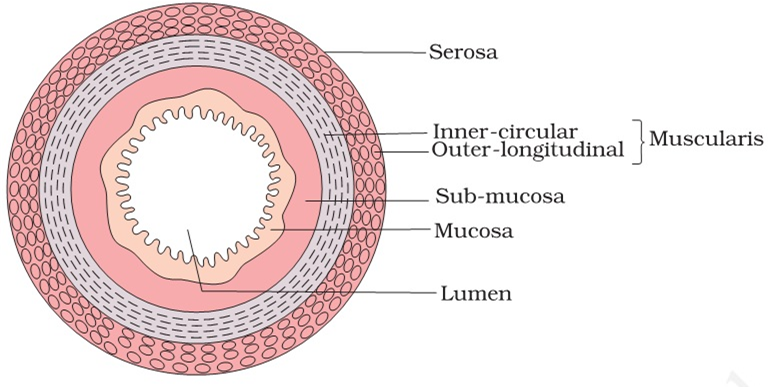
Name different types of teeth and their number in an adult human.
Different types of teeth and their number in an adult human are:
i. Incisors (I) : Total number is 8
ii. Canine (C) : Total number is 4
iii Premolars (PM) : Total number is 8
iv. Molars (M) : Total number is 12
Butter is a fat product and gets digested in the small intestine. The bile juice secreted by the liver contains bile salts that break down large fat globules into smaller globules, so as to increase their surface area for the action of lipase. This process is referred to as emulsification of fats.
After this, the pancreatic lipase present in the pancreatic juice and the intestinal lipase present in the intestinal juice hydrolyse the fat molecules into triglycerides, diglycerides, monoglycerides, and ultimately into glycerol.
Absorption of fats:
Fat absorption is an active process. During fat digestion, fats are hydrolysed into fatty acids and glycerol. However, since these are water insoluble, they cannot be directly absorbed by the blood. Hence, they are first incorporated into small droplets called micelles and then transported into the villi of the intestinal mucosa.
They are then reformed into small microscopic particles called chylomicrons, which are small, protein-coated fat globules. These chylomicrons are transported to the lymph vessels in the villi. From the lymph vessels, the absorbed food is finally released into the blood stream and from the blood stream, to each and every cell of the body.
Discuss the main steps in the digestion of proteins as the food passes through different parts of the alimentary canal.
Digestion of proteins : Proteins do not get any justice in buccal cavity.
Digestion of proteins in stomach : The food which comes from buccal cavity into stomach is called bolus. As bolus comes into stomach, immediately enteric epithelium secretes a gastrin hormone. It compels gastric glands to release gastric juice. Gastric juice has HCI, propepsin, prorennin and weak gastric lipase.
Functions of HCI:
1. It is germicidal.
2. It makes medium acidic.
3. It converts propepsin into pepsin.
4. It converts prorennin into rennin.
5. It retards the contraction and relaxation of stomach wall.
6. It stops the action of saliva.
Functions of pepsin :
1. Converts proteins to peptones.
2. Digests collagen.
3. Converts calcium paracaseinate to peptones.
Functions of Rennin : Converts casein of milk into paracasein.
Digestion of proteins into duodenum : In duodenum the food is mixed with bile and pancreatic juice.
Pancreatic juice : It contains 3 proenzymes namely.
1. Tripsinogen : It is converted into trypsin by enterokinase. Trypsin once formed itself converts trypsinogen into trypsin. This process is called autocatalysis and trypsin acts as autocatalyst.
2. Chymotrypsinogen : It is converted to chymotrypsin by trypsin.
3. Procarboxypeptidase : It is converted to carboxypeptidase in the presence of trypsin.
Functions of Trypsin and Chymotrypsin :
1. Converts proteins to peptides.
2. Trypsin acts on keratin present in exoskeleton and converts that to peptones.
Functions of carboxy-peptides : It separates amino acids present adjacent to carboxylic acid group in peptides.
The food is called chyle which passes into jejunum-ileum.
Digestion of proteins in jejunum-ileum : As chyle comes into jejunum-ileum, it is mixed with mucus and intestinal juice. The intestinal juice contains following protein digesting enzyme.
Aminopeptidase : It separates amino acids adjacent to amino group.
Dipeptidase converts dipeptides to amino acids.
Answer briefly
(c) What are the basic layers of the wall of alimentary canal?
The basic layers of the alimentary canal are :
i. Serosa - It is the outermost layer of the human alimentary canal. It is made up of a thin layer of secretory epithelial cells, with some connective tissues underneath.
ii. Muscularis is a thin layer of smooth muscles arranged into an outer longitudinal layer and an inner circular layer.
iii. Submucosa is a layer of loose connective tissues, containing nerves, blood, and lymph vessels. It supports the mucosa
iv. Mucosa is the innermost lining of the lumen of the alimentary canal. It is mainly involved in absorption and secretion
